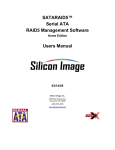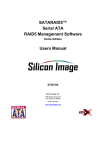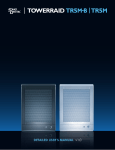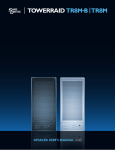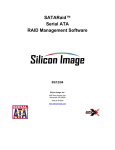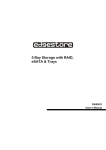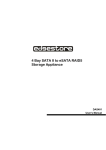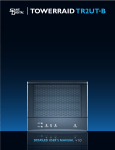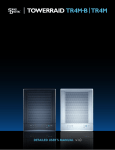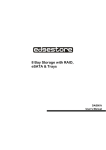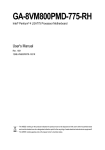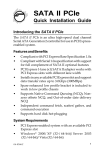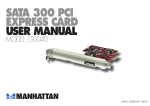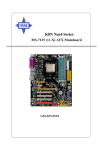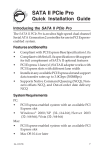Download Windows RAID5 Manual - Bare-Bone
Transcript
SiI3132 SATARAID5™ Storage Management Software User Manual Home Edition Silicon Image, Inc. 1060 East Arques Ave. Sunnyvale CA 94085 (408) 616-4000 www.siliconimage.com Copyright © 2004, Silicon Image, Inc. All rights reserved. No part of this publication may be reproduced, transmitted, transcribed, or translated into any language or computer format, in any form or by any means without prior written permission of: Silicon Image, Inc. 1060 East Arques Ave. Sunnyvale CA 94085 Silicon Image, Inc. reserves the right to make changes to the product(s) or specifications to improve performance, reliability, or manufacturability. Information furnished is believed to be accurate and reliable, but Silicon Image, Inc. shall not be responsible for any errors that may appear in this document. Silicon Image, Inc. makes no commitment to update or keep current the information contained in this document. However, no responsibility is assumed for its use; nor any infringement of patents or other rights of third parties, which may result from its use. No liability is assumed as a result of their use or application. No rights under any patent accompany the sale of any such product(s) or information. Silicon Image, Inc. products are not designed or intended for use in Life Support Systems. A Life Support System is a product or system intended to support or sustain life, which if it fails, can be reasonably expected to result in significant personal injury or death. If Buyer or any of its direct or indirect customers applies any product purchased or licensed from Silicon Image, Inc. to any such unauthorized use, Buyer shall indemnify and hold Silicon Image, Inc., its affiliates and their respective suppliers, harmless against all claims, costs, damages and expenses arising directly or indirectly, out of any such unintended or unauthorized use, even if such claims alleges that Silicon Image, Inc. or any other person or entity was negligent in designing or manufacturing the product. Specifications are subject to change without notice. SATARAID5 is a trademark of Silicon Image, Inc. JAVA is a trademark of Sun Microsystems, Inc. Windows is a trademark of Microsoft Corp. for their family of computer operating systems. Document Number: TBD Revision History: Revision Comment 1.00 Initial creation of document 04/06/04 1.01 Updated for beta release. 04/30/04 1.02 Included “For SATARAID users” section. 05/07/04 1.03 Update chapter 6 based on BIOS changes. 06/17/04 1.04 Minor edits and clarifications 06/26/04 1.05 Update for new features for configuring SATARAID5. 06/30/04 1.06 Replaced some screen pictures with new ones to show the new product name. 07/01/04 1.07 Updated for release 1.2 which includes Port Multiplier support and Concatenation 03/08/05 1.08 Updated for 3132 and reorganized. 04/06/05 Copyright © 2004 Silicon Image Inc. 2 Date SATARAID5 User’s Manual Table of Contents 1 WELCOME ........................................................................................................................................................5 1.1 DATA ENHANCEMENT .....................................................................................................................................5 1.1.1 DATA SECURITY .............................................................................................................................................5 1.1.2 DATA PERFORMANCE .....................................................................................................................................5 1.1.3 DATA VERSATILITY .......................................................................................................................................5 1.2 EASE OF USE.....................................................................................................................................................5 1.3 SUPPORTED OPERATING SYSTEMS .................................................................................................................5 2 AN INTRODUCTION TO RAID .....................................................................................................................6 2.1 2.2 2.3 2.3.1 2.3.2 2.3.3 2.3.4 2.3.5 2.3.6 2.4 3 INSTALLATION ...............................................................................................................................................9 3.1 3.1.1 3.2 3.3 3.3.1 3.3.2 3.4 3.4.1 3.4.2 3.4.3 3.4.4 4 RAID VOLUMES ..............................................................................................................................................6 SEGMENTING DISKS.........................................................................................................................................6 RAID LEVELS ..................................................................................................................................................7 DISK STRIPING (RAID 0) ...............................................................................................................................7 DISK MIRRORING (RAID 1) ...........................................................................................................................7 DISK MIRRORING AND STRIPING (RAID 10) .................................................................................................7 PARITY RAID (RAID 5).................................................................................................................................7 CONCATENATION ...........................................................................................................................................8 JBOD (JUST BUNCH OF DISKS)......................................................................................................................8 RAID VOLUME STATUS ..................................................................................................................................8 UPGRADING FROM PREVIOUS SILICON IMAGE RAID SOFTWARE ..............................................................9 LEGACY RAID SUPPORT ................................................................................................................................9 SOFTWARE COMPONENTS ...............................................................................................................................9 INSTALLING FROM THE INSTALLSHIELD ........................................................................................................9 INSTALLING THE DRIVER AND GUI................................................................................................................9 INSTALLING THE JAVA RUN TIME ENVIRONMENT .....................................................................................11 INSTALLING MANUALLY ...............................................................................................................................12 DRIVER .........................................................................................................................................................12 SATARAID5 MANAGER .............................................................................................................................13 JAVA RUN TIME ENVIRONMENT.................................................................................................................13 INSTALLING BIOS (ADVANCED)..................................................................................................................13 SATARAID5 MANAGER...............................................................................................................................14 4.1 OVERVIEW......................................................................................................................................................14 4.2 CREATING RAID GROUPS ............................................................................................................................14 4.2.1 CONCATENATED RAID GROUPS ..................................................................................................................16 4.3 ADDITIONAL MENU COMMANDS ..................................................................................................................16 4.3.1 CONFIGURATION ..........................................................................................................................................18 4.3.2 EXIT ..............................................................................................................................................................20 4.3.3 CREATE SPARE .............................................................................................................................................21 4.3.4 DELETE SPARE .............................................................................................................................................21 SATARAID5 User’s Manual Copyright © 2004 Silicon Image Inc. 3 4.3.5 DELETE MEMBER .........................................................................................................................................21 4.3.6 DELETE ORPHAN ..........................................................................................................................................22 4.3.7 DEVICE SUMMARY .......................................................................................................................................23 4.3.8 REBUILD RAID GROUP ................................................................................................................................26 4.3.9 DELETE RAID GROUP ..................................................................................................................................26 4.3.10 RAID GROUP SUMMARY ...........................................................................................................................26 4.3.11 TASK MANAGER .........................................................................................................................................29 4.3.12 ........................................................................................................................................................................29 4.3.13 ........................................................................................................................................................................30 4.3.14 ........................................................................................................................................................................30 4.3.15 EVENT LOG.................................................................................................................................................33 4.3.16 ........................................................................................................................................................................34 4.3.17 RESOURCES ................................................................................................................................................34 4.3.18 CREATE LEGACY RAID GROUP .................................................................................................................35 4.3.19 REBUILD LEGACY RAID GROUP ...............................................................................................................35 4.3.20 DELETE LEGACY RAID GROUP .................................................................................................................36 4.3.21 CONVERT LEGACY RAID GROUP ..............................................................................................................36 4.3.22 CREATE LEGACY SPARE.............................................................................................................................37 4.3.23 DELETE LEGACY SPARE .............................................................................................................................37 4.3.24 CONVERT LEGACY SPARE ..........................................................................................................................38 4.3.25 HELP TOPICS ..............................................................................................................................................39 4.3.26 ABOUT ........................................................................................................................................................39 5 5.1 5.2 5.3 5.4 5.5 5.6 5.7 5.8 5.9 6 CREATING AND DELETING LEGACY RAID GROUPS WITH BIOS UTILITY ...............................40 CREATING RAID GROUPS ............................................................................................................................42 CREATING SPARE DRIVE ...............................................................................................................................44 CREATING JBOD ...........................................................................................................................................44 DELETING RAID GROUPS, SPARE DRIVE, AND JBOD ...............................................................................44 REBUILD RAID 1 SET ....................................................................................................................................46 RESOLVING CONFLICTS ................................................................................................................................47 LOW LEVEL FORMATTING ............................................................................................................................49 LOGICAL DRIVE INFORMATION....................................................................................................................49 RESERVED DRIVE AND SETTING SIZE FOR RAID SET, SPARE DRIVE, OR JBOD.....................................49 ALLOCATING PARTITIONS IN WINDOWS............................................................................................51 6.1 WINDOWS SERVER 2003 & XP & 2000........................................................................................................51 6.1.1 CREATING THE PARTITIONS .........................................................................................................................52 Copyright © 2004 Silicon Image Inc. 4 SATARAID5 User’s Manual 1 Welcome Silicon Image’s SATARAID5TM software enhances your data storage by combining advanced RAID1 features typically seen on high-end data systems with low cost/high capacity Serial ATA drives. By using industry standard SATA drives and Silicon Image Host Bus Adapters, you can achieve extraordinarily low costs while remaining assured that your data is protected against hardware failure. 1.1 Data Enhancement 1.1.1 Data Security SATARAID5 provides our highest commitment to data security through the use of RAID architecture to backup and protect data. RAID levels 1, 5, and 10 provide data security as described in Section TBD below. It also supports sophisticated sparing support such that hardware failure risk can be minimized by automatically regenerating the failed disk’s data on a backup disk. The software driver includes support for S.M.A.R.T.2 monitoring to predict suspect drives. 1.1.2 Data Performance SATARAID5 can also increase storage throughput by combining the throughput of multiple drives into a single volume. RAID levels 0, 5, and 10 support this ability. Furthermore, each volume can be tailored to provide the best performance for the data contained on that disk. 1.1.3 Data Versatility The driver also supports JBOD3, Contiguous and Concatenated drives for applications which do not require increased security or performance. 1.2 Ease of Use The SATARAID5 Manager GUI offers an easy to use utility for creating and managing your storage. It also supports the latest SATA enhancements including SATA-II Port Multiplier support, and up to 3Gbit/sec transfer rates on controllers that support that speed. Creating and deleting volumes is also possible without requiring a restart of the operating system and rebuilds never require the data to be taken off-line. Drives can also be moved between controllers without losing the data. 1.3 Supported Operating Systems The following operating systems are supported by the SATARAID5 driver. Check the Silicon Image website for additional operating systems as they are supported. • • • Windows XP, 32 bit Windows 2000, 32 bit Windows 2003, 32 bit 1 Redundant Array of Independent Devices, a method of combining drives to provide better protection and/or performance. 2 Self Monitoring, Analysis and Reporting Testing. 3 Just a Bunch of Disks SATARAID5 User’s Manual Copyright © 2004 Silicon Image Inc. 5 2 An Introduction to RAID 2.1 RAID Volumes RAID technology allows one or more disks to be combined into a logical volume which provides greater performance and/or protection than standard disk drives. These volumes, also known as RAID Groups, appear like regular disk drives to the operating system and can be partitioned, formatted and used just like any other normal disk. The complexity of the RAID is hidden within the driver. There are several different methods of combining disks, each with its own advantages and disadvantages. Each method is referred to as a RAID “level” such as RAID 1, or RAID 5. The details of each level are summarized below and detailed in the following sections. RAID Level 0 1 5 Advantages Excellent performance, low cost Excellent data protection Good data protection, good value 10 High performance, excellent data protection. Good performance, low cost Same as single disk Concatenation JBOD 2.2 Disadvantages No data protection High cost Some performance degradation for writes. High cost. No data protection Same as single disk Segmenting Disks For increased versatility, the SATARAID5 software allows individual disks to be divided into smaller segments which can then be combined into different volumes. As an example, if a user has one set of data that must be protected at all costs, another set of data which should be protected at reasonable cost and another set that doesn’t need any protection at all, the user can divide three disks into sections as shown in Figure 1. The yellow regions define the high security volume, the greem section is the middle security volume and the light blue shows the unprotected area. Figure 1: Dividing Disks into Members Copyright © 2004 Silicon Image Inc. 6 SATARAID5 User’s Manual 2.3 RAID Levels 2.3.1 Disk Striping (RAID 0) Striping is a performance-oriented, non-redundant data mapping technique. While Striping is discussed as a RAID Group type, it is does not provide any fault tolerance. With modern SATA and ATA bus mastering technology, multiple I/O operations can be performed in parallel, enhancing data throughput. Striping arrays use multiple disks to form a larger virtual disk. The figure below illustrates a three-disk stripe set. Stripe one is written to disk one, stripe two to disk two, and so forth. RAID 0 sets can be comprised of two, three, or four drives. Stripe0 Stripe1 Stripe2 Stripe3 Stripe4 Stripe5 Stripe6 Stripe7 Stripe8 Stripe9 Stripe10 Stripe11 2.3.2 Disk Mirroring (RAID 1) Disk mirroring creates an identical twin for a selected disk by having the data simultaneously written to two disks. This redundancy provides instantaneous protection from a single disk failure. If a read failure occurs on one drive, the system reads the data from the other drive. RAID 1 sets are comprised of two drives. A third drive can be allocated as a spare in case one of the drives in the set fails. Block 0 Block 1 Block 0 Block 2 Block 1 Block 3 Block 2 Block 3 2.3.3 Disk Mirroring and Striping (RAID 10) RAID 10 combines the features of both RAID 0 and RAID 1. Performance is provided through the use of Striping (RAID 0), while adding the fault tolerance of Mirroring (RAID 1). The implementation of RAID 10 requires four drives. The drives are assigned as two sets of striped pairs. The data is written to RAID Group A, which is striped (RAID 0). This allows maximum speed. The data is then mirrored to another RAID 0 striped set, which is Set B in the figure above. This provides data redundancy (RAID 1), and thus increased data security. Under certain circumstances, a RAID 10 set can sustain multiple simultaneous drive failures. 2.3.4 Parity RAID (RAID 5) Parity or RAID 5 adds fault tolerance to Disk Striping by including parity information with the data. Parity RAID dedicates the equivalent of one disk for storing parity stripes. The data and parity information is arranged on the disk array so that parity is SATARAID5 User’s Manual Copyright © 2004 Silicon Image Inc. 7 written to different disks. There are at least 3 members to a Parity RAID set. The following example illustrates how the parity is rotated from disk to disk. Parity RAID uses less capacity for protection and is the preferred method to reduce the cost per megabyte for larger installations. Mirroring requires 100% increase in capacity to protect the data whereas the above example only requires a 50% increase. The required capacity decreases as the number of disks in the group increases. 2.3.5 Concatenation Concatenation combines multiple disks or segments of disks into a single large volume. It does not provide any data protection or performance improvement but can be useful for utilizing left over space on disks. Concatenation allows the segments which make up the volume to be of difference sizes. 2.3.6 JBOD (Just Bunch of Disks) The JBOD is a virtual disk that can either be an entire disk drive or a segment of a single disk drive. For home edition, JBOD function only supports one disk. 2.4 RAID Volume Status A RAID Volume can be in any one of the following statuses. Status Meaning Good All disks are currently functioning Normal Degraded For RAID levels which contain some data protection, one or more disks have failed but the data is still available via the RAID algorithms. The failed disk should be replaced as soon as possible. Rebuilding A failed disk drive has been replaced and the data is being regenerated on the replacement disk. When complete, the RAID Group will return to Good status. Resynchronizing An error has occurred which requires that the RAID algorithms be regenerated on this RAID Group. When complete, the RAID Group will return to Good status. Failed One or more disks have failed and RAID algorithms can no longer regenerate the data. The minimum number of failures required to reach this state depends on the RAID level RAID 0, Contiguous, Concatenated, JBOD: Single disk failure RAID 1, 5, 10: Two drive failure Copyright © 2004 Silicon Image Inc. 8 SATARAID5 User’s Manual 3 Installation 3.1 Upgrading From Previous Silicon Image RAID Software If you are upgrading from a previously released Silicon Image RAID driver, please read the following sections carefully. 3.1.1 Legacy RAID Support Previous RAID drivers which do not support RAID 5 functionality are known as “Legacy” drivers and are being replaced with the SATARAID5 software. Legacy RAID volumes are still supported by the SATARAID5 software and have the following benefits. • • • 3.2 Legacy volumes can be used as boot devices. Legacy volumes can be created and managed by the BIOS menu during system boot. Legacy RAID 0 and 10 volumes support a stripe size of 4K. Software Components There are four separate components that must be installed for SATARAID5 software to function. These components are the BIOS (Basic Input/Output System), SATARAID5 Driver, SATARAID5 Manager, and Sun’s JAVA Run Time Environment. The steps on how to install these packages is described in the following sections. 3.3 Installing from the Installshield The simplest way to install SATARAID5 software is by using the SATARAID5 installshield. This will quickly and easily install the SATARAID5 Driver, SATARAID5 Manager and JAVA Run Time Environment. To begin, insert the Silicon Image SATARAID5 Installation CD-ROM into the CD drive or download it from Silicon Image’s website. Then double click on the Error! Unknown document property name. file to begin the installation process. 3.3.1 Installing the Driver and GUI Once the InstallShield is started, the following screens will appear SATARAID5 User’s Manual Copyright © 2004 Silicon Image Inc. 9 Click “Next” to pass the welcome screen. Click the Next button to install the SATARAID5 program in the default directory (recommended). An alternate directory may be selected if desired. Copyright © 2004 Silicon Image Inc. 10 SATARAID5 User’s Manual 3.3.2 Installing the JAVA Run Time Environment The Java Run Time Environment installation will automatically start once the InstallShield has finished installing the driver and GUI. Once started, the following dialog screens will appear. Followed by When a window appears asking for acceptance the license agreement, select I accept the terms of this license agreement and click Next. SATARAID5 User’s Manual Copyright © 2004 Silicon Image Inc. 11 Choose the Typical setup type and click Next. When the installation completes, click Finish. Restart the computer when prompted. 3.4 Installing Manually To manually install individual components of the SATARAID5 software, please refer to the following sections. 3.4.1 Driver The SATARAID5 driver can be installed using the normal Windows® driver install/upgrade interface. To begin, insert the CDROM into the CD drive. If a new Si3132 Host Bus Adapter has been inserted into the system or this is the first time you are installing the SATARAID5 software, Windows will open a “New Hardware Detected” Dialog. Follow the instructions and choose “Install the software automatically (Recommended)”. If a previous version of SATARAID5 is installed, the install driver dialog can be started as follows: From My Computer icon: Right click on My Computer and select Manage. Click on “Device Manager”. From Control Panel: Select “System” and click on the “Hardware” tab at the top of the dialog. Select “Device Manager” Copyright © 2004 Silicon Image Inc. 12 SATARAID5 User’s Manual Once the Device Manager is started, select “SCSI and RAID controllers” as shown below. Right click on the desired Host Bus Adapter and select “Update Driver…”. Make sure the installation CD-ROM is in the CD drive and select “Install the software automatically (Recommended)”. Press “Next” to install the software. 3.4.2 SATARAID5 Manager To install the SATARAID5 Manager, copy the files from the “Manager Files” directory on the installation CD-ROM to any desired directory on the host. For easy startup, create a shortcut on the directory to the file “sam.jar”. Sun’s JAVA Run Time Enviroment must be installed before the SATARAID5 Manager will run. 3.4.3 JAVA Run Time Environment. The JAVA Run Time Environment is available from Sun Microsystems web site at http://java.sun.com/j2se/downloads.html. Please follow the directions to install the JAVA software. 3.4.4 Installing BIOS (Advanced) The BIOS (Basic Input/Output System) is software contained on the Host Bus Adapter hardware itself which manages the RAID volumes during system bootup. Typically, the BIOS does not have to be updated and changing it is not recommended for non-advanced users. If you must update the BIOS, start the Device Manager as described above, expand the “SCSI and RAID controllers” field and right click on the appropriate Host Bus Adapter card. Select “Properties” and click on the BIOS tab of the XXXX dialog. If the BIOS tab is not available, please contact Silicon Image for further instructions. SATARAID5 User’s Manual Copyright © 2004 Silicon Image Inc. 13 4 SATARAID5 Manager 4.1 Overview The SATARAID5 Manager is the Graphical User Interface (GUI) which allows you to create and manage RAID volumes. The Manager initially shows two windows as seen below. The RAID Groups window identifies SATA host adapters and configured RAID groups. For systems with more than one Silicon Image Host Bus Adapter installed, you can switch between cards by selecting the desired card in the RAID Groups Window. When a controller is selected, the RAID Groups currently defined on that controller are also shown in the RAID Groups Window. Selecting a specific RAID Group will highlight the segments associated with that volume in the Device Configuration Window. The Device Configuration window identifies all physical drives and their partitions. If the adapter supports SATA-II Port Multipliers, there may be more than one device ID per SATA channel. Throughout the Manager, different colors are used to indicate the status of the components. The meaning of the colors are Color Green Yellow Red Grey 4.2 Status Good. The component and all subcomponents are okay. Warning. This component or at least one subcomponent has become degraded and requires service. Failed. This component or at least one subcomponent has failed. Unused. Creating RAID Groups To begin creating a new RAID Group, select “Create RAID Group” from the RAID Group menu or right click on a controller in the RAID Groups window and select “Create RAID Group”. This will cause the Create RAID Group dialog to appear. Copyright © 2004 Silicon Image Inc. 14 SATARAID5 User’s Manual The fields are defined as follows: RAID Group Label: Provides an identifiable name for the RAID group. This field can be any ASCII string to help the user identify this volume. RAID Group: Select a Group ID from the available ID list. The maximum number of RAID Groups per controller is 8 so Group ID can be any number between 0 and 7 inclusive. Configuration: The configuration indicates which RAID level is to be used to configure these members. The options are: Contiguous (for virtual disk or JBOD) Concatenated (for multiple concatenated segments) Striped (for RAID 0) Mirrored (for RAID 1) Mirrored Striped (for RAID 10) Parity RAID (for RAID 5) Capacity: This defines the total usable capacity of the RAID Group. Either select an entry from the pull down list or manually enter the volume size in Gigabytes. Selecting MAX will create the largest RAID set possible with the drive(s) selected. Chunk Size: Chunk size, also known as stripe size, is for advanced users who want to tune their box for the greatest performance. In general, large stripe sizes are best for large files that are accessed sequentially (e.g. media streaming files) whereas smaller sizes are better for randomly accessed data like databases. This parameter is not used for Contiguous, Concatenated, Mirrored or JBOD RAID levels. Rebuild Priority: Rebuild priority indicates how quickly the controller should rebuild data on a disk following a hardware failure. A value of 1 is the lowest priority and will take the longest to rebuild. A value of 10 is the highest priority and will rebuild the fastest but may require more CPU resources which could have some impact on the computer’s performance. This parameter is not used for Contiguous, Concatenated, Striped or JBOD RAID levels. Devices: Select RAID member devices from the available device segment list. The minimum number of disks is determined by the RAID level as shown in the following table. SATARAID5 User’s Manual Copyright © 2004 Silicon Image Inc. 15 RAID Level 0 1 5 10 JBOD Concatenated Min # of Disks 2 2 3* 4* 1 1 Once all parameters have been selected, select “Create” to create the RAID Group. When finished, press Cancel to exit the Create RAID Group Dialog. 4.2.1 Concatenated RAID Groups Concatenated RAID Groups allow the user to select different sized segments for each member of the volume. For Concatenated volumes only, a second dialog box will appear allowing the user to select the individual segment sizes from each disk. Enter the desired values and press Create to create the RAID Group. 4.3 Additional Menu Commands The Main menu commands are shown below File Device RAID Group Window Legacy Support Help Configuration … Create Spare Create RAID Group Task Manager Create Legacy RAID Group Help Topics Exit Delete Spare Rebuild RAID Group Event Log Rebuild Legacy RAID Group About Delete Member Delete RAID Group Resources Delete Legacy RAID Group Delete Orphan RAID Group Summary Device Summary Convert Legacy RAID Group Create Legacy Spare Delete Legacy Spare Convert Legacy Spare * For 3132, this requires the use of a Port Multiplier device to access more than one disk per SATA channel. Copyright © 2004 Silicon Image Inc. 16 SATARAID5 User’s Manual Legacy Spare The commands are documented on the pages that follow. SATARAID5 User’s Manual Copyright © 2004 Silicon Image Inc. 17 4.3.1 Configuration SATARAID5 configuration options include customization of the settings for Log File, Popup, and Advanced Options. This command displays a dialog box to let user set different configurations for SATARAID5 with the following three tabs: Log File Tab The log file is used to store event information received from all Silicon Image RAID drivers. The log file is a text file and can be viewed with any text viewer (such as Notepad) or with the Event Log window of SATARAID5. Use the Log File tab to set the location and the desired filename for the log file. Copyright © 2004 Silicon Image Inc. 18 SATARAID5 User’s Manual Popup Tab SATARAID5 can be configured to notify the user of events using messages in popup windows. Use the slider control to set the event level for popups to occur: - Error Level - The following events will trigger a popup window: Errors - Warning Level - The following events will trigger a popup window: Warnings Errors - Information Level - The following events will trigger a popup window: Informational Warnings Errors - Disable All - No events will trigger a popup window. SATARAID5 User’s Manual Copyright © 2004 Silicon Image Inc. 19 Advanced Options The Advanced Options tab is used to control advanced features of the RAID driver. By default, all these advanced options are disabled. The following features are supported: 1. Legacy (Bootable) Support – When this feature is selected, Legacy Support menu will be available in the menu bar. The Legacy Support Menu includes a list of menu items to support RAID functions for legacy RAID groups. For detailed Legacy Support features, refer to sections from Create Legacy RAID Group to Convert Legacy Spare. 2. Delete Member Support – When this feature is selected, Delete Member menu item will be available under the Device menu. The Delete Member menu item allows the user to delete a member from RAID 1 (Mirroring), RAID 5 (Parity RAID), and RAID 10 (Striping and Mirroring) groups. For detailed Delete Member feature, refer to section Delete Member. 3. Advanced RAID Features – When this feature is selected and user selects to create RAID group, if the RAID group to be created is fault tolerance group (RAID 1, RAID 5, or RAID 10), user will be able to select Improper Shutdown Policy in the Create RAID Group dialog box. The Advanced RAID Features are not supported for Legacy RAID groups. 4. Resources Info Support – When this feature is selected, Resources menu item will be available under the Window menu. This feature is for debugging purpose only. For detailed Resources feature, refer to section Resources. 4.3.2 Exit This command terminates the SATARAID5 program. Copyright © 2004 Silicon Image Inc. 20 SATARAID5 User’s Manual 4.3.3 Create Spare This command displays a dialog box to let user create Spare Drive, user needs to select the following parameters: Spare Type: Global -- the spare drive is for all RAID groups in the system. Dedicated -- the spare drive is dedicated to the specified RAID group. RAID Group: Select the RAID group to which this spare drive is dedicated. This parameter is enabled only when Dedicated spare type is selected. Capacity: Select from a list of spare drive size, current options are from 128 MB to 100 GB and MAX. Device: Select one device segment from the available device segment list 4.3.4 Delete Spare This command displays a dialog box to let user choose one or more Spare Drives to delete. 4.3.5 Delete Member This command displays a dialog box to let user choose RAID groups’ members to delete. Since RAID 0 is not fault-tolerant, RAID 0 members will not be shown in the list. Note: delete RAID group member will reduce the RAID group to be a non-fault-tolerant RAID group. SATARAID5 User’s Manual Copyright © 2004 Silicon Image Inc. 21 4.3.6 Delete Orphan An orphan device segment is part of a RAID group that cannot access another device segment within the same RAID group. When a member of a RAID group fails in a severe manner (such as a loss of power or a complete hard disk failure), it becomes an orphan. This command displays the Delete Orphan Segment window to show all orphan segments and allow user to delete selected orphan segments. Copyright © 2004 Silicon Image Inc. 22 SATARAID5 User’s Manual 4.3.7 Device Summary This command displays the Segment Summary window to show all physical devices’ segments. The Segment Summary window has it’s own menu bar. All options available via the menu bar are shown below File Options Exit Sorting… Fields… Exit This command closes the Task Summary window. Sorting This command sorts the rows based on the selected field. SATARAID5 User’s Manual Copyright © 2004 Silicon Image Inc. 23 Copyright © 2004 Silicon Image Inc. 24 SATARAID5 User’s Manual Fields This command displays a dialog box to let user choose which fields will be shown in the Segment Summary window. SATARAID5 User’s Manual Copyright © 2004 Silicon Image Inc. 25 4.3.8 Rebuild RAID Group This command displays a dialog box to let user choose a replacement segment to rebuild a non-fault tolerant RAID group. 4.3.9 Delete RAID Group This command displays a dialog box to let user choose RAID groups to delete. 4.3.10 RAID Group Summary This command displays a dialog box to show all RAID groups’ group ID, configuration, and status. Copyright © 2004 Silicon Image Inc. 26 SATARAID5 User’s Manual The RAID Group Summary window has it’s own menu bar. All options available via the menu bar are shown below File Options Exit Sorting… Fields… Exit This command closes the RAID Group Summary window. SATARAID5 User’s Manual Copyright © 2004 Silicon Image Inc. 27 Sorting This command displays a dialog box to let user choose up to 3 items to sort RAID group items in the RAID Group list. Fields This command displays a dialog box to let user choose which fields will be shown in the RAID Group Summary window. Copyright © 2004 Silicon Image Inc. 28 SATARAID5 User’s Manual 4.3.11 Task Manager This command displays the Task Manager window. The Task Manager window lists all RAID and disk management tasks that have been started and/or done. This window provides user the ability to schedule any RAID and disk management operations including RAID group creation, rebuild, and test. The Task Manager window has it’s own menu bar. All options available via the menu bar are shown below File Options Task Open… Sorting… Modify… Save… Fields… Suspend… Print… Resume… Exit Cancel… Delete… Open This option will be available in future revisions. Save This option will be available in future revisions. 4.3.12 Print SATARAID5 User’s Manual Copyright © 2004 Silicon Image Inc. 29 This option will be available in future revisions. 4.3.13 Exit This command closes the Task Summary window. Sorting This command displays a dialog box to let user choose up to 3 items to sort task items in the task list. 4.3.14 Fields This command displays a dialog box to let user choose which fields will be shown in the task list. Modify This command allows user to modify parameters of the selected task items. The following is an example of changing rebuild priority for a rebuild task. Copyright © 2004 Silicon Image Inc. 30 SATARAID5 User’s Manual Suspend This command allows user to suspend the selected task items. Resume This command allows user to resume the suspended task items. SATARAID5 User’s Manual Copyright © 2004 Silicon Image Inc. 31 Cancel This command allows user to cancel the selected task items. Delete This command displays a dialog box to let user delete the selected task items from the task list in Task Summary window. The following dialog box will pop up to get confirmation from the user. Copyright © 2004 Silicon Image Inc. 32 SATARAID5 User’s Manual 4.3.15 Event Log This command displays the Event Log window. The Event Log window displays SATA device-related events that occur while SATARAID5 is running. The Event Log window has it’s own menu bar. All options available via the menu bar are shown below File Options Exit Sorting… Fields… Exit This command closes the Event Log window. SATARAID5 User’s Manual Copyright © 2004 Silicon Image Inc. 33 Sorting This command displays a dialog box to let user choose up to 3 items to sort event items in the event log. 4.3.16 Fields This command displays a dialog box to let user choose which fields will be shown in the event log. 4.3.17 Resources This command displays the Resource Information window. This feature is for debugging purpose only. Copyright © 2004 Silicon Image Inc. 34 SATARAID5 User’s Manual 4.3.18 Create Legacy RAID Group This command displays a dialog box to let user create legacy RAID group. This item is disabled if new RAID groups exist. User needs to select the following parameters: RAID Group: Select a group ID from the available ID list Configuration: Striped (for RAID 0) Mirrored (for RAID 1) Mirrored Striped (for RAID 10) Parity RAID (for RAID 5) Capacity: Select from a list of RAID group size, current options are from 256 MB to 100 GB, and MAX. Chunk Size: Select one from the available list: 8, 16, 32, 64, 128 (KB). RAID 1 set does not require this. Devices: Select RAID member devices from the available device segment list 4.3.19 Rebuild Legacy RAID Group This command displays a dialog box to let user choose a replacement segment to rebuild a non-fault tolerant legacy RAID group. SATARAID5 User’s Manual Copyright © 2004 Silicon Image Inc. 35 4.3.20 Delete Legacy RAID Group This command displays a dialog box to let user choose legacy RAID groups to delete. This item is disabled if no legacy RAID groups exist. 4.3.21 Convert Legacy RAID Group This command displays a dialog box to let user choose legacy RAID groups to convert to new RAID groups of the same RAID type (configuration). This item is disabled if no legacy RAID groups exist. Copyright © 2004 Silicon Image Inc. 36 SATARAID5 User’s Manual 4.3.22 Create Legacy Spare This command displays a dialog box to let user create legacy spare drive. This item is disabled if new RAID groups exist. 4.3.23 Delete Legacy Spare This command displays a dialog box to let user delete legacy spare drive. This item is disabled if no legacy spare drive exists. SATARAID5 User’s Manual Copyright © 2004 Silicon Image Inc. 37 4.3.24 Convert Legacy Spare This command displays a dialog box to let user choose legacy spare drives to convert to new spare drives. This item is disabled if no legacy spare drives exist. Copyright © 2004 Silicon Image Inc. 38 SATARAID5 User’s Manual 4.3.25 Help Topics This command opens an interactive help dialog using the standard Windows help interface. This option will be available in future revisions. 4.3.26 About This command displays a dialog box with more information about the SATARAID5 program, including the revision level. SATARAID5 User’s Manual Copyright © 2004 Silicon Image Inc. 39 5 Creating and Deleting Legacy RAID Groups with BIOS Utility Legacy RAID sets and JBOD can be created and managed by either the BIOS utility or the SATARAID5 GUI. New RAID groups must be created and managed by the SATARAID5 GUI. During boot up, a screen similar to that below will appear for about 5 seconds. Press CTRL+S or the F4 key to enter the BIOS RAID utility. The RAID Utility menu screen will be displayed. A brief description of each section is presented on the next page. Copyright © 2004 Silicon Image Inc. 40 SATARAID5 User’s Manual Main Menu The Main Menu in the upper left corner is used to choose the operation to be performed. The selections are: Create RAID Group Delete RAID Group Rebuild RAID 1 Set Resolve Conflicts Low Level Format Logical Drive Info Create RAID Group is used to create a new legacy RAID Set or for allocating legacy spare drives. Delete RAID Group is used to delete a legacy RAID Set or to deallocate a legacy spare drive. Rebuild RAID 1 Set is used to initiate the rebuild of a RAID 1 set after, for example, a drive in the Group has been replaced. Resolve Conflicts is used to automatically find the member drives of a RAID set which has been disrupted (physical drives swapped around, for example) and restore the Set to proper operation. Low Level Format allows a single drive to have its data completely wiped out. Drives assigned to Sets or allocated as spares cannot be low level formatted. Logical Drive Info shows the current configuration of each RAID set, allocated spare, and unallocated physical drive attached to the SATA host adapter. These operations are detailed in the pages that follow. Help Window This window displays context-sensitive help and status messages. Physical Drive Information This window displays the model number and capacities of the drives physically attached to the SATA host adapter. Logical Drive Information This window displays all logical drives connected to the controller. The upper part lists RAID sets and JBOD drives reported to the system BIOS. The lower part lists spare drives, reserved drives, conflict drives, and invalid drives not reported to the system BIOS. Command Line The bottom line of the display lists the currently active command keys: Up and Down arrows select the menu item or action ESC takes the user to the previous menu Enter selects the highlighted choice Ctrl-E exits the utility Other keys may be active depending upon the currently selected action. SATARAID5 User’s Manual Copyright © 2004 Silicon Image Inc. 41 5.1 Creating RAID Groups As previously discussed, the Silicon Image SATA host adapter supports RAID 0, 1, 5, 10, and JBOD configurations. The selection of the RAID level to be used should be based upon factors including performance, data security, and number of drives available. It is best to carefully consider the long-term role of the system and plan the data storage strategy appropriately. Silicon Image has made the creation of RAID sets very simple. They can be created either automatically or to allow the greatest flexibility, manually. 1. Select “Create RAID set” 2. Choose a RAID 0 Striped, a RAID 1 Mirrored, a RAID 5 Parity, or a RAID 10 combination set. 3. Select Automatically or Manually configuration of the RAID Set. Copyright © 2004 Silicon Image Inc. 42 SATARAID5 User’s Manual 4. If manual configuration is selected, the chunk size of Striped Sets can be selected. For Mirrored Sets, the Source and Target drives can be selected. 5. If auto configuration is selected, BIOS will select RAID member drives automatically and the chunk size of Striped Sets is set to 64KB. 6. Select RAID set size with ↑ and ↓ keys. See section 6.9 for explanation on selecting size. 7. After the RAID set size is set, the message “Are You Sure?” will display before completing the configuration. Answer “N” to abort the creation of the new RAID set, or “Y” to proceed with the RAID set creation. SATARAID5 User’s Manual Copyright © 2004 Silicon Image Inc. 43 8. 5.2 RAID sets can be created in both BIOS and in the SATARAID5 GUI. If you have excess capacity left on your hard drives after creating a RAID set in the BIOS, you can later go to the SATARAID5 GUI to create additional logical drives that fully utilize the capacity on all your hard drives. Creating Spare Drive If there is a RAID 1 set, spare driver can be created. The spare drive can be allocated to the RAID 1 set in the event of a failure of one of the drives in the RAID 1 set. 1. To create a spare drive for RAID 1 set, Select “Create RAID set” 2. Select “Spare Drive” and press Enter. 3. Select spare drive from the physical drive list and press Enter. 4. Select spare drive size with ↑ and ↓ keys. See section 6.9 for explanation on selecting size. 5. After the spare drive size is set, the message “Are You Sure?” will display before completing the configuration. Answer “N” to abort the creation of the spare drive, or “Y” to proceed with the spare drive creation. 5.3 Creating JBOD Since BIOS no longer reports non-RAID drives to the system BIOS, if a non-RAID boot drive or data drive is desired, a JBOD can be created so BIOS will report it to the system BIOS. 1. To create a JBOD, Select ”Create RAID set” 2. Select “JBOD” and press Enter. 3. Select JBOD drive from the physical drive list and press Enter. 4. Select JBOD size with ↑ and ↓ keys. See section 6.9 for explanation on selecting size. 5. After the JBOD size is set, the message “Are You Sure?” will display before completing the configuration. Answer “N” to abort the creation of the JBOD, or “Y” to proceed with the JBOD creation. 5.4 Deleting RAID Groups, Spare Drive, and JBOD 1. To remove one or more RAID sets, spare drives, and JBODs, select “Delete RAID set” 2. Select the desired item to delete from the logical drive list and press Enter. 3. Press “Y” when asked, “Are You Sure?” 4. The drives will be returned to the selection of logical drives from which a new RAID set can be created. Copyright © 2004 Silicon Image Inc. 44 SATARAID5 User’s Manual SATARAID5 User’s Manual Copyright © 2004 Silicon Image Inc. 45 5.5 Rebuild RAID 1 Set This menu selection is used to initiate the copying of data from an existing drive to a replacement drive that has been installed in a RAID 1 set after the failure of one of the members. 1. Select “Rebuild RAID 1 set” 2. Select the desired set and press Enter. 3. Press “Y” when asked, “Are You Sure?” 4. The set will be rebuilt. The status of the rebuild is displayed in the MAIN MENU window. Copyright © 2004 Silicon Image Inc. 46 SATARAID5 User’s Manual 5.6 Resolving Conflicts When a RAID set is created, the metadata written to the disk includes drive connection information including the channel on the host adapter to which it is connected. If after a disk failure the replacement disk was previously part of a RAID set or used in another system, it may have conflicting metadata, specifically in reference to the drive connection information. If so, this will prohibit the RAID set from being either created or rebuilt. In order for the RAID set to function properly, this old metadata must be first overwritten with the new metadata. To correct this, select “Resolve Conflict” and the correct metadata, including the correct drive connection information; will automatically be written to the replacement disk. 1. Select “Resolve Conflicts” and press Enter. 2. Select the “Conflict” entry in the Logical Drive Status window and press Enter. SATARAID5 User’s Manual Copyright © 2004 Silicon Image Inc. 47 3. Note that some conflict resolutions may result in the drive letter assignment changing; for example the RAID set may have been drive D: but after the conflict resolution, it may become drive E. Be aware of this when performing a conflict resolution. To maintain the same drive lettering, the SATA cables connected to the drives may need to be swapped, or in the case of a SATA-based removable drive unit, the order of the drives within the chassis made need to be changed. Press ‘Y’ to accept the change and resolve the conflict. 4. The conflict will be resolved. The RAID Set will appear in the Logical Drive window. Copyright © 2004 Silicon Image Inc. 48 SATARAID5 User’s Manual 5.7 Low Level Formatting The Low Level Format menu selection allows the complete erasure of data on a hard drive. This is not an action, which typically needs to be performed as formatting the drive under Windows is usually sufficient to prepare the drive for use. 5.8 Logical Drive Information This menu item allows the display of the assignment of physical drives within a logical set (RAID set, RAID 1 spare, or unassigned). It is a display-only function. Use the up and down arrow keys to scroll between the drives in the Logical Drive Properties window. Press the ESC key when done viewing logical drive information. 5.9 Reserved Drive and Setting Size for RAID Set, Spare Drive, or JBOD Once a physical drive has been used to create a RAID set, spare drive, or JBOD by BIOS utility, BIOS saves user selected set or drive size in the reserved area of the physical drive. There is no way to remove the reserved area information even after the SATARAID5 User’s Manual Copyright © 2004 Silicon Image Inc. 49 user deletes the set or drive. For this reason, after a set or drive is deleted, BIOS recognizes the physical drive as a reserved logical drive and it will not report the drive to the system BIOS. When user selects to create a RAID set, spare drive, or JBOD, he or she has to select size for the set or drive. BIOS will set a default size for it and user can use the ↑ and ↓ keys to change the size. If the physical drive has never been used to create a set or drive by the BIOS before, the full size of the physical drive will be set as default size. Otherwise, BIOS will set default size to the size it saved in the reserved area of the physical drive before. If the user wants to increase the default size, BIOS will display a warning message in the help window and for user’s response before changing the default size. Copyright © 2004 Silicon Image Inc. 50 SATARAID5 User’s Manual 6 Allocating Partitions in Windows After the RAID groups have been created either using SATARAID5 Manager or BIOS Menu Utility, the RAID group must have a partition defined on it, then the RAID group must be formatted in preparation for use under Windows. Windows XP, 2000, and Server 2003 use the Disk Management utility that is part of the Operating System. There are enough nuances that make it important to follow the procedure specific to the Operating System. 6.1 Windows Server 2003 & XP & 2000 Before creating any partitions, RAID groups must first be created using the BIOS RAID Utility or the SATARAID5 GUI. Once the sets have been created, allow the system to load Windows. Once Windows is running, open the Disk Management window located at: Control Panel> Administrative Tools> Computer Management> Storage> Disk Management A window similar to the following should appear: This window has three main sections: 1) System listing of all formatted and available disks/RAID Groups. 2) Report of physical connection of disks/RAID Groups. 3) Report of partition status, disk letter, and volume name. In the physical connection window, every disk should report as: Basic Disk Size (the actual available disk space will be reported here) Online SATARAID5 User’s Manual Copyright © 2004 Silicon Image Inc. 51 Instead of “Basic,” a disk may also report as either “Unknown” or “Dynamic.” If the disk reports as “Unknown” right-click on the disk icon and click “Write Signature.” A window will appear with the disk in question (all “Unknown” disks may appear in this window). Make sure the box next to each disk is checked, and then click OK. The disk should now report as “Basic.” If a disk reports as “Dynamic,” right-click on the icon of that disk, and click on “Revert to Basic Disk...” Within seconds the disk should report as Basic. 6.1.1 Creating the Partitions In the Report of physical connection of disks/RAID Groups section, the order in which the drives are displayed corresponds directly to the order the Sets appear in the BIOS. Therefore, the first Unallocated Partition represents Set 1, and so on. 1. In this example, there are two disks with unallocated partitions. Right-click on the partition of the first disk and click on “Create Partition...” 2. The “Create Partition Wizard” should appear. The first window is an introductory window to the Wizard. Click Next. 3. The second window designates the partition type. Choose primary partition and click Next. Copyright © 2004 Silicon Image Inc. 52 SATARAID5 User’s Manual 4. The third window designates the partition size. Since this is a Striped RAID set utilizing 2 disk drives, the size of the partition will be approximately twice the size of the smallest single disk drive. Click Next. 5. The fourth window designates the drive letter of the partition. Change the drive letter if desired. Click Next. SATARAID5 User’s Manual Copyright © 2004 Silicon Image Inc. 53 Copyright © 2004 Silicon Image Inc. 54 SATARAID5 User’s Manual 6. The next window allows the volume label to be set and selection of the type of formatting to take place upon the creation of the partition. Make sure the Format this partition. . .” radio button is selected. Name the volume as desired (suggestions are generic names such as STRIPED SET or something specific to use such as FINANCIAL, CRITICAL, MISCELLANEOUS, etc.). It is recommended to use the default NTFS for the file system. Click Next. 7. The last window is a summary window listing all of the selections made. After verifying that everything is correct, click Finish. SATARAID5 User’s Manual Copyright © 2004 Silicon Image Inc. 55 The status of the newly created partition in the Disk Management window should change to Formatting and the percentage complete will be displayed. Depending upon the size of the partition, the format process may take several minutes. When complete, the status will change to “Healthy” and the name and drive letter will be updated. Once the disk reports Healthy, it appears in the listing in System Listing section with all of its pertinent information as well. Repeat the above procedure as needed for any other partitions. Close the Data Management window by clicking on the small boxed “X” in the top right corner of the window. Click on the “My Computer” icon on the Desktop. The new drives will be visible and properly named. The new disks are available for use. Copyright © 2004 Silicon Image Inc. 56 SATARAID5 User’s Manual
























































